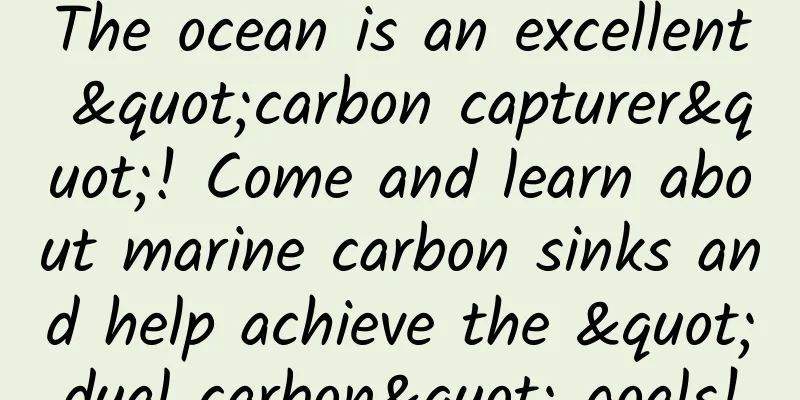The ocean is an excellent "carbon capturer"! Come and learn about marine carbon sinks and help achieve the "dual carbon" goals!

|
All known life on Earth is based on carbon as organic matter. About 3.8 billion years ago, the early carbon-based life on Earth was born in the depths of the ocean. Today, carbon is widely present around us and is active in the material exchange of various spheres on the earth's surface. In the vast ocean, plankton in the euphotic layer (the part of the water layer through which light can pass) fixes carbon dioxide through photosynthesis, and then enters the deep sea in the form of filter feeding and sedimentation. Carbonate also exists in the material composition of beautiful coral reefs. Let's take a look at the outstanding performance of the ocean in carbon storage and fixation. Oceans: Climate Buffer The process, activities and mechanisms of absorbing carbon dioxide from the atmosphere through marine activities and marine organisms and fixing and storing it in the ocean are called marine carbon sinks. The "carbon" referred to in marine carbon sinks includes various forms, from fresh fish and shrimps, to carbonate and bicarbonate ions dissolved in water, to the carbonate shells of shellfish. Schematic diagram of the process of carbon dioxide entering the ocean (drawing/Zhang Ling) The ocean accounts for 71% of the Earth's surface area. This huge carbon reservoir stores 20 times more carbon than land and 50 times more carbon than the atmosphere. Since the Industrial Revolution, about 48% of the carbon dioxide produced by humans has been absorbed by seawater. It can be said that the ocean is an important "buffer zone" for regulating global climate change. Nanliu River Estuary, Beihai City, Guangxi Zhuang Autonomous Region In addition to absorbing atmospheric carbon dioxide, the ocean also has a strong storage effect on solid sediment carbon contained in sediments. China's total coastline is 32,000 kilometers long, of which 18,000 kilometers are on the mainland and 14,000 kilometers are on islands. Thousands of rivers flow into the ocean. People carry out fishery farming, production and living sewage discharge and other activities at the seaside, which makes the marginal sea (the sea located at the edge of the continent and the ocean, with the continent on one side and the peninsula, island or island arc on the other side, but the water exchange is smooth) need to store about 80% of the sedimentary organic carbon in the entire ocean. Rivers entering the sea carry carbon-containing sediments from the land, and bury them together with mud and sand on the seabed of the marginal sea, preventing the carbon from being decomposed into carbon dioxide and entering the air. Marine life: Carbon transporters Marine organisms convert inorganic carbon into organic carbon and sink it to the deep sea, which is a natural "carbon sink" for carbon fixation and storage. Take whales as an example. This large mammal can weigh up to 200 tons and live up to 100 years. They can store a large amount of carbon for a long time. This carbon stored in organisms is called biomass carbon. Not only that, after the death of a whale, the whale will sink to the bottom of the sea, isolated from the world for millions of years. This part of biomass carbon is equivalent to being permanently sealed on the seabed, becoming "dead carbon", that is, carbon that will not produce a greenhouse effect. Plankton in the ocean absorbs and fixes carbon in the seawater environment, converting it into particulate and dissolved organic carbon, which is then recycled through predation and decomposition by upper species in the food chain. In addition, fish schools swim up and down in waters of different depths every day, excreting carbon-rich fecal particles into the sea. These particles sink underwater and may take a long time to circulate back to the surface of the sea. A carbon fixation expert growing in coastal wetlands Marine carbon sinks are not limited to the storage of carbon in seawater and the seabed. Ecosystems such as mangroves, salt marshes, and seagrass beds in coastal wetlands are experts in absorbing and fixing carbon dioxide. They can quickly absorb carbon dioxide from the environment through photosynthesis and preserve it in the form of branches, leaves, rhizomes, etc., making a huge contribution to reducing the concentration of carbon dioxide in the atmosphere. However, if these ecosystems are destroyed, the fixed carbon may be decomposed and returned to the carbon cycle. Coastal wetland ecosystems are experts in absorbing and fixing carbon dioxide Paying attention to the role of marine and coastal ecosystems in fixing carbon can not only slow down global warming, but also create carbon sinks that can be used for "blue carbon trading" (marine carbon sinks can be traded on the market based on relevant certification). Understanding and developing marine carbon sinks will enhance the carbon fixation and storage potential of China's ecosystems and help achieve the "dual carbon" goal as soon as possible. |
Recommend
China Mobile: TD-LTE voice call success rate has reached 98%
During the 2014 Shanghai Mobile Asia Communication...
Kiryu Kazuma's gorgeous farewell "Yakuza 6" review
He is full of pride and refuses to admit defeat. ...
Foshan jewelry mini program customized development, who is the best jewelry mini program?
With the opening of various functions of mini pro...
The strongest flare since 2019! It will continue in the next three days and may affect the power grid and navigation signals
According to the National Space Weather Monitorin...
Introduction to Wolf Totem: How to do SEO promotion and what are the channels?
As companies become more familiar with the Intern...
National Love Teeth Day | You thought it was a mouth ulcer, but it might actually be cancer! Open your mouth and take a look...
Today is September 20th, National Love Teeth Day....
ViaPlay F2 game controller review: a game controller that beats touch screens
Hello guys~ Today we The packaging is very straig...
Which technology will become a must-have in the future of see-through television?
Although television is a traditional technology p...
The shortcut from a novice to an expert in SEM bidding, you will regret it if you don’t read it!
The growth path of SEMer is a process of fighting...
Microsoft showcases HoloLens holographic glasses at its flagship store in New York
Starting today, the HoloLens experience display s...
China Automotive Industry Research Institute: Chinese cars will occupy nine of the top ten Russian car sales in August 2024
Recently, China Automotive Industry Research Inst...
The latest news from the Ministry of Human Resources and Social Security: 100 million migrant workers have gone out to work!
A total of 18.6 billion yuan in job retention sub...
What are the advantages of Baidu information flow that makes it popular with advertisers?
What advantages does Baidu information flow have ...
Chinese mobile phones only have craftsmanship but no craftsmanship? !
The so-called difference between craftsmanship an...
One billion snow crabs mysteriously disappeared, and not being able to eat crab legs is just a trivial first step
Red snow crab legs as long as your arm are the cr...









